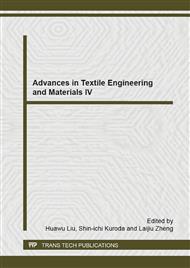[1]
S.L. Zheng, Non-metallic mineral filler surface activity in the application present situation and development prospect of plastic products[J]. China Non-Metallic Mining Industry Herald, 1990, (1): 7-12.
Google Scholar
[2]
H.Y. Li, R.G. Wang, H.L. Hu, W.B. Liu Surface modification of self-healing poly (urea- formaldehyde) microcapsules using silane-coupling agent Appl. Surf. Sci., 255 (2008), p.1894-(1900).
DOI: 10.1016/j.apsusc.2008.06.170
Google Scholar
[3]
J. Zhao, M. Milanova, M.M.C.G. Warmoeskerken, V. Dutschk. Surface modification of TiO2 nanoparticles with silane coupling agents. Colloid Surf. A: Physicochem. Eng. Aspects, 413 (2012), pp.273-279.
DOI: 10.1016/j.colsurfa.2011.11.033
Google Scholar
[4]
W. Liu, Z.P. Xie, C. Jia Surface modification of ceramic powders by titanate coupling agent for injection molding using partially water soluble binder system J. Eur. Ceramic Soc., 32 (2012), pp.1001-1006.
DOI: 10.1016/j.jeurceramsoc.2011.11.017
Google Scholar
[5]
J.L. Zhang, Z.C. Guo, X. Zhi, H.Q. Tang. Surface modification of ultrafine precipitated silica with 3-methacryloxypropyltrimethoxysilane in carbonization process, Colloid Surf. A: Physicochem. Eng. Aspects, 418 (2013), pp.174-179.
DOI: 10.1016/j.colsurfa.2012.11.057
Google Scholar
[6]
J.T. Lin, J.H. Lin, Characterization of powder quartz surface modification and their effects[J], China Non-Metallic Mining Industry Herald, 2004, 27(3): 16-17.
Google Scholar
[7]
P.C. Ma, J. -K. Kim, B.Z. Tang Functionalization of carbon nanotubes using a silane coupling agent Carbon, 44 (2006), p.3232–3238.
DOI: 10.1016/j.carbon.2006.06.032
Google Scholar
[8]
S. Yun, Q.Q. Song, D.M. Zhao, G.M. Qian, X.N. Li, W. Li. Study on the inorganic–organic surface modification of potassium titanate whisker Appl. Surf. Sci., 258 (2012), p.4444–4448.
DOI: 10.1016/j.apsusc.2012.01.003
Google Scholar
[9]
M.H. Yang, D.Q. Tan, D.L. Chen, Preparation and application of the active powder quartz[J], China Non-Metallic Mining Industry Herald, 2002, 25(5): 33-34.
Google Scholar
[10]
Q.S. Chen, Quartz powder surface modification and its effect[J], China Non-Metallic Mining Industry Herald, 2004, 24(2)l5-l7.
Google Scholar
[11]
J.T. Lin, F. Zhang, J.T. Li, Several kinds of coupling agent modification of powder quartz modification effect comparative study, Mineral and chemical workers2007, (7):l2-l6.
Google Scholar


